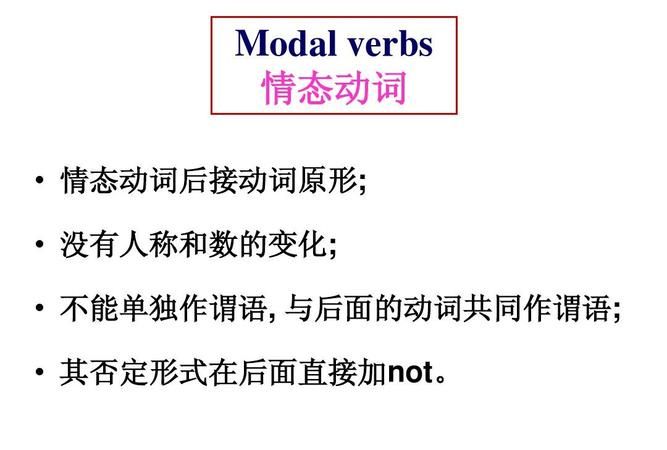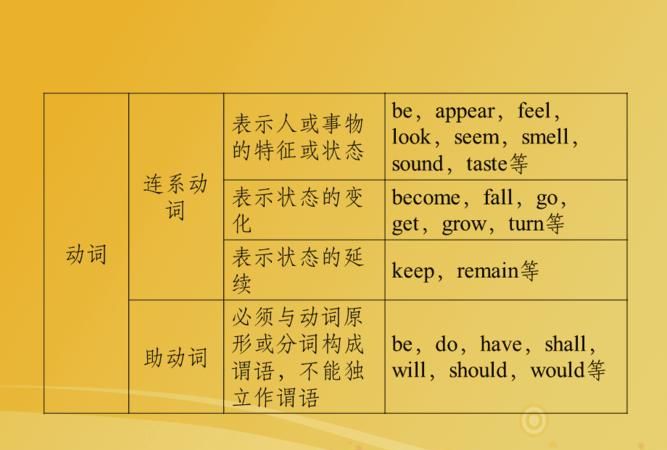本文目录
初中英语语法 什么是情态动词和名词
我认为情态动词和普遍动词的区别在于:
1、情态动词可以和Be动词一样直接和not构成否定句,而普遍动词通常不可以。
如:She
can't
swim.
2、情态动词可直接用于疑问句,普通动词则需要利用助动词。
如:Can
you
sing
this
song?
What
can
i
do?
3、情态动词后跟普通动词时,普通动词用原形。
其实初中英语考试中,情态动词应该是比较简单的一类了。

初中英语情态动词的用法归纳ppt
情态动词可以说是初中英语的必考内容之一,通常情况下情态动词会在完形填空、阅读理解中出现,当然, 作文 里大家也会适当运用情态动词,那么,什么是情态动词,情态动词又该怎么运用呢,下面就来具体了解一下。
初中英语情态动词的用法归纳
定义
情态动词表示说话人对某一动作或状态的态度,表示“可能”,“可以”,“需要”,“必须”,“应当”等意思。情态动词没有人称和数的变化,后面的动词要用原形。
情态动词的种类:
初中英语情态动词的用法归纳,情态动词用法有哪些
情态动词的常见用法:
1.can和could的用法
(1)can/could 表示“能力;许可;可能性”等。could 为 can 的过去式。如:Can I use your book?我可以用你的书吗?
(2)can 用在疑问句中,表示征求意见、请求许可,答语仍用 can; could 用在疑问句中,比can 更委婉、客气,是一种礼貌的说法,并不表示过去时态,答语用can,而不能用could。
Eg: -Could you tell me the way to the park?你能告诉我去公园的路吗?
-Sorry. I can't. I'm new here。不好意思,我不知道。我是新来的。
[注意]
①can 和could 只能用于现在时和过去时两种时态。
②另外, can't 可表示否定推测。
2.may和might的用法
may/might 意为“可以”,表示同意、许可或请求对方许可,也可表示祝愿。
might 是may 的过去式,有两种用法:一种表示过去式;一种表示虚拟语气,使语气更加委婉、客气,或表示可能性更小。
以may开头的一般疑问句,其否定回答用mustn't。
Eg: MayI use your book? 我可以用你用的书吗?
He might be alive. 他可能还活着。
【注意】
can和may都可以用来表示请求或允许,但may比can更正式,更客气。
3.must和should
(1)must意为“必须,应当”,含有一种命令的语气,比较生硬,不容商量。否定形式mustn't, 表示“不得”,“一定不要”。如:
Eg:You mustn't drive after drinking。你绝不能酒后驾车。
①must 与 have to 的区别: must 表示说话人的主观意愿;have to 表示客观需要。
②回答由must 引导的疑问句:
肯定回答:Yes, …must. 如:
-Must I go home now?
-Yes, you must.
否定回答:No,…needn't./No,…don't/doesn't have to.
Eg:-Must I go home now?
-No, you needn't. 。
③must 表示对事物的推测,意为“想必;一定”,只用于肯定句中;表“推测”时,情态动词与动词原形,(常为be动词)连用,
如:The man must be your teacher。那个人一定是你的老师。
(2)should意为“应当,应该”,表示建议或劝告,语气比较委婉,客气。否定形式为shouldn’t。
Eg: You should get up early.
You shouldn't eat too much sugar.
4.will和would
1)用于疑问句,表示说话人向对方提出请求或询问,用would比will更委婉,更客气。
如:Will you please open the window?
Would you like some coffee?
2) would表示建议“你愿意…吗”
-Would you like to go shopping with me?
-Yes, I’d love to. /I’d love to. But I’m busy now.
[注意区别]
①I’d like+n. … 我想要…(接名词)
如:I’d like some water.
②I’d like to + v. … 我想要做…(接动词原形)
如:I’d like to go with Tom.
5、shall用于第一人称 (I, we), 可以表示“将”和表示建议 “……好吗?”
eg: ①Where shall we have dinner?
②-Shall we go fishing? -
- All right. \OK. \Good idea.
情态动词的实际运用
一、考查can的用法
a.考查can表示能力的用法。
在这一用法中,can表示能力,意思是"能,会",其否定式can't表示"不能"。在过去时中用could和couldn't。例如:
1.-Where's Mr Lee? I have something unusual to tell him.
-You________find him. He________Japan. (2003黑龙江)
A. may not; has gone to B. may not; has been to
C. can't; has gone to D. can't; has been to
2.-Finish drawing a horse in ten minutes. OK?
-Sorry. It________in such a short time. (2003山东威海)
A. may do B. can't be done
C. must do D. needn't be done
3. I have my own room in my house, so I________do what I want in it. (2002江西)
A. must B. have to C. need to D. can
4.________you mend my car? I______not start it. (2002常德市)
A. Would; would B. Must; must C. Can; can D. May; may
5.________she ride when she was three years old?( 2002长沙市)
A. Can B. Could C. Need D. May
6. The boy________answer this kind of hard questions one year ago.(2002四川省)
A. can B. may C. could
b.考查can表示推测的用法。
在这一用法中,can意为"可能",表示客观可能性,常常用于疑问句和否定句中。例如:
7. Who is the man over there? Is it Mr Li?
-No, it________be him. Mr Li is much taller. (2003河北)
A. mustn't B. may not C. can't D. needn't
8. -Listen! Someone is singing in the next room. Who________it be? Is it Wei Fang?
-No. It________be her. She is at school now. (2002重庆市)
A. will; may not B. must; mustn't C. may; can't D. may; won't
9. -Is Mr Hu in the reading room?
-No, he________be there. He has gone to Tianjin. (2002新疆)
A. mustn't B. needn't C. won't D. can't
10. Class 3 won the football match! ________it be true?(2002广东)
A. May B. Must C. Will D. Can
c.考查can / could表示请求许可的用法?
在这一用法中,can和could都表示现在,用could比用can语气更加委婉客气,常用Could I / you...?句式,表示"我/你能……吗?"
若表示同意要用can,不用could?例如:
11.-Could I look at your pictures?
-Yes, of course you________. (2003武汉)
A. could B. can C. will D. might
12.________you pass me a pen? I'd like to write down the telephone number. (2002北京市海淀区)
A. Need B. Could C. Must D. Should
参考答案:1. C 2. B 3. D 4. C 5. B 6. C7. C 8. C 9. D 10. D
二、考查may的用法
a.考查may表示请求许可的用法
在这一用法中,may表示许可或征询对方许可,表示"可以"的意思,常常与第一人称I连用,构成May I...?句式,表示"我可以……吗?"肯定回答用Yes, you may.; Yes, please.等;否定回答用No, you can't.或No, you mustn't.,不用No, you may not.?例如:
25. -________I have your name, please?
-Yes, Michael. M-I-C-H-A-E-L. (2002北京市东城区)
A. Must B. Will C. May D. Need
26. -May I go to the cinema, dad?
-No, you________. You must finish your homework first. (2002浙江金华市)
A. mustn't B. won't C. don't D. needn't
27. -May I smoke here?
-________, you________. It can be dangerous. (2002滨州市)
A. Yes; can B. No; can't
C. Yes; may D. No, needn't
②测试may表示可能性的用法。
在这一用法中,may表示可能性,意思是"也许","可能",通常用于肯定句中。例如:
28. You________go and ask Meimei. She________know the answer. (2003天津)
A. must; can B. must; may
C. need; can D. can; may
29. Look out! The knife is very sharp. You________cut your finger. (2002宁夏)
A. need B. must C. should D. may
参考答案:25. C 26. A 27. B
初中英语情态动词的用法归纳相关 文章 :
1. 初中英语情态动词之shall和should的正确用法
2. 中考英语语法专题详解七:情态动词、系动词
3. 初中英语情态动词之 used to
4. 初中英语基础知识归纳总结
5. 初中英语语法知识归纳
6. 初中英语必须掌握的19个重点语法知识点
7. 情态动词should的用法总结
8. 初中英语动词的知识点总结
9. 初中英语语法知识点总结
10. 初中英语语法总结

初中英语常见的情态动词有哪些
一、情态动词 can 的用法 1. 表示能力,意为“能、会”。如: —— Can you swim? 你会游泳吗? —— Yes,I can. 是的,我会。 —— Can you play the guitar? 你会弹吉它吗? —— No,I can’t. 不,我不会。 2. 表示请求或允许,多用于口语中,意为“可以、能”等。 如: Can I help you? 我可以帮忙吗? You can go home now. 现在你可以回家了。 3. 用于否定句、疑问句中,表示猜测、怀疑或不肯定。 如: —— Where can it be? 它可能会在哪儿? —— It may be in your pencil-box. 也许在你的文具盒里。 二、情态动词 may 的用法 1. 表示“许可、准许、请求许可”,此时与 can 同义,可以互换使用。 如: You may / can go to the cinema this evening. 你今晚可以去看电影。 注意: 许可对方时,其答语可以用 Yes,you may. 但由于用 may 作肯定回答,语气显得生硬、严肃,因而一般常用 Yes, please. / Certainly. / Of course. 等。这些肯定答语显得热情、客气。如: —— May I use your ruler? 我可以用一下你的尺子吗? —— Certainly. Here you are. 当然可以。给你。 拒绝对方时,其答语可以用 No,you mustn’t. / No,you can’t. 或 Sorry,you can’t. / No,please don’t. 等说法。如: —— May I watch TV now? 现在我可以看电视吗? —— No,you mustn’t. 不,不可以。 2. 表示可能性,意思为“可能、也许”,常用在肯定句中。 如: He may know you. 他可能认识你。 The may go to the Great Wall next week. 他们可能下周去长城。 注意: 在否定句中一般不用 may not ,常用 can’t 表示“不可能”。例如: He can’t be at home tonight. 今晚他不可能在家。 3. 用于特殊疑问句中,表示不确定,常可译为“会”。如: Who may call me at night? 谁会在晚上给我打电话呢? 4. 表示希望、祈求、祝愿,常可译为“祝愿”。如: May you have a good time. 祝你过得愉快。 May you be happy! 祝你幸福!

初中英语情态动词的主要句型有什么作用
情态动词可以表达说话人的某种情感、态度。下面和我一起了解一下,供大家参考。
英语情态动词的主要句型
1、Can I help you? ——Yes, please. / No, thanks.
2、Can + 主语 + 动词原形? Yes, ~ can. No, ~ can’t.
3、Can I borrow your book?----Yes,of course.
4、Can I write on the book? ------No, you can’t\mustn’t.
5、Could \Can you help me?---- Yes,of course.\Certainly.\ Sure.
6、Could \Can you tell me the way to the Zoo?
7、May I come in?----- Come in, please.
8、May I sithere?----- Yes, please.\Sorry, please don’t.
9、May I have someCoke?---- Yes, of course.
10、May/ Could / Can I speak toTom? -----Speaking. Who’s calling?
11、should 、shouldn’t 表示劝告:(1)He should get up early.(2)She shouldn’t play computer game too much.
12、Should +主语 +动词原形? Yes, ~ should.\ No, ~ shouldn’t.
初中英语情态动词的特征
(1)适用于主语的各种人称和数(have to 比较特殊,其主语是第三人称单数时用has to),并且没有被动语态。例如:He has to go home now.
(2)个别情态动词有现在式和过去式两种形式,但过去式有时会用来传达比用现在式更加客气、委婉的语气。
(3)情态动词的否定:一般直接在后面加否定词。

以上就是关于情态动词初中英语 ,初中英语语法 什么是情态动词和名词的全部内容,以及情态动词初中英语 的相关内容,希望能够帮到您。

